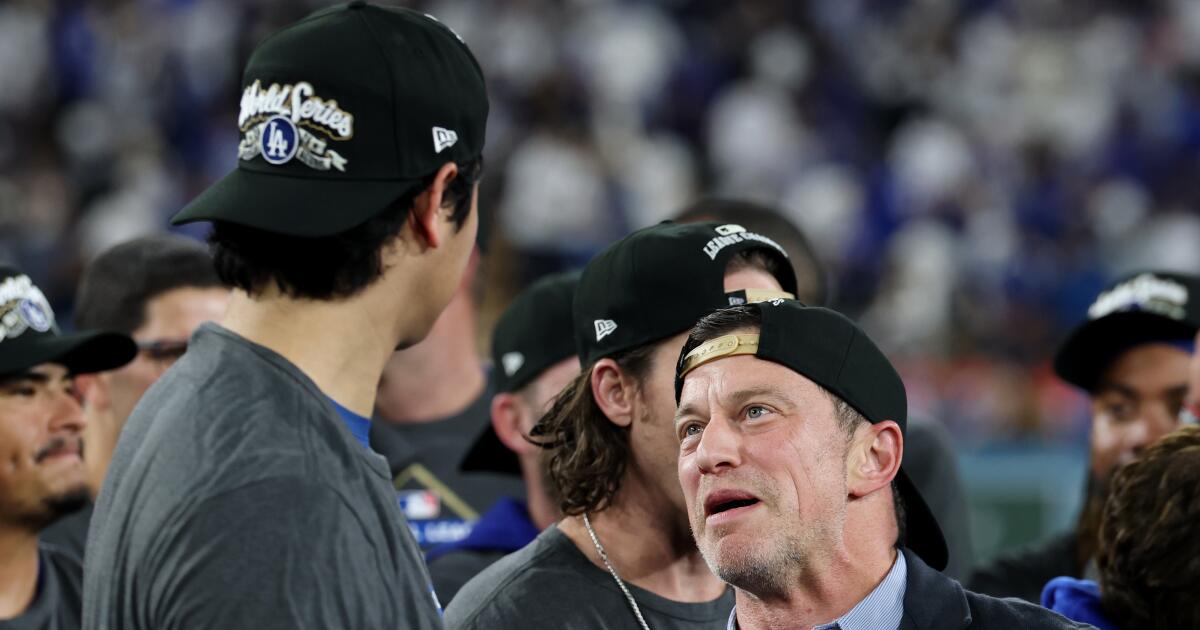Dodgers offseason yet to heat up. Will Winter Meetings create spark?
ORLANDO, Fla. — At the start of this offseason, the Dodgers signaled a willingness to be patient and methodical in building their roster for 2026.
At the start of this week’s MLB Winter Meetings, at least, the team arrives in Orlando having thus far remained true to form.
Compared to their whirlwind offseasons the past two winters, the Dodgers have been conspicuously quiet in the wake of their second consecutive World Series championship. Their only free-agent deal has been the re-signing of veteran infielder Miguel Rojas. Their only trade was a swap of minor-league pitchers with the Seattle Mariners. The biggest news, to this point, was their decision to non-tender reliever Evan Phillips (and they could very well wind up bringing him back).
Behind the scenes, there have been efforts for more, of course. The team came up short in pursuit of free-agent relievers Raisel Iglesias and Devin Williams. They have canvassed the trade market and laid potential groundwork for possible future moves.
But for now, exactly what their winter will hold remains a largely unanswered question.
And, in all likelihood, it could ultimately be dictated by whom they’re willing to part with as they go about re-shaping their roster.
All offseason, the trade market has looked like the Dodgers’ most logical path to upgrading their roster — the place they could most easily shore up their needs in the bullpen and outfield, while still avoiding having to add another long-term contract to their expensive and aging core.
There are targets galore to go after, too, from Brendan Donovan or Lars Nootbaar of the St. Louis Cardinals, to Jarren Duran or Wilyer Abreu of the Boston Red Sox, to potentially even bigger names like Cleveland’s Steven Kwan or Minnesota’s Byron Buxton (though the latter is reportedly unlikely to be dealt this offseason).
Oh, and as long as there remains even a slim chance of two-time Cy Young-winning pitching Tarik Skubal getting traded by the Detroit Tigers, you can bet the Dodgers will be monitoring that situation, too.
For president of baseball operations Andrew Friedman and Co., the task will be trying to line up a trade package to pull off on any of those moves.
The Dodgers have plenty of chips to bring to the bargaining table, with ample young pitching depth and a minor-league farm system considered perhaps best in the sport. But balancing it all while finding value is still a challenge. Which is why, as trade rumors fly, don’t be surprised to see a potentially wide range of familiar names bandied about in such speculation.
The team’s most obvious trade bait, of course, remains their collection of young talent. They have a crop of highly-touted outfielder prospects they could potentially deal from, including Josue De Paula, Zyhir Hope, Eduardo Quintero and several others. They have a former top prospect in Dalton Rushing, who struggled through his rookie year but still possesses promising raw tools.
Most of all, they have plenty of young pitchers who could also help fetch a nice return, from ascendant minor-league prospect Jackson Ferris, to returning 2024 breakout rookies River Ryan and Gavin Stone, to potentially even more established big-league names like Justin Wrobleski (a natural starting pitcher who was stuck in more of a swingman role in the bullpen last year) and Emmet Sheehan (who is about at the same stage of his career that former top Dodgers prospect Ryan Pepiot was when he was dealt two winters ago).
The Dodgers, however, are still prioritizing the future. They want to go for a historic three-peat next season. But they also know, at some point in the coming years, they will need to cycle in a new generation of talent to maintain their championship window.
Thus, any young player traded now will come with a potential future cost.
Which could help explain why, in recent weeks, young players have not been the only ones caught up in trade rumors around the team.
Last month, ESPN cited one anonymous MLB executive who described Tyler Glasnow as a potential “sleeper name” on this year’s trade market. Last week, The Athletic reported that Teoscar Hernández’s name has come up in trade discussions, too.
Granted, the odds of either getting dealt appear low. And for now, they figure to remain key cogs in next year’s pursuit of another World Series title.
At the same time, however, they are also veterans approaching their mid-30s, with significant salaries due over the next several seasons. And if the Dodgers were to find deals to move them — either as a way to shore up other spots of the roster, or to offload money for a potential free-agent signing — it’s far from unfeasible that the club could pull the trigger.
After all, for a front office that is conscious of its roster’s advancing age, and trying to juggle both short- and long-term goals, such considerations reflect the wide net the Dodgers are believed to be casting this offseason; the kind of deliberate, exploratory mode they’ve been in while evaluating potential paths through this winter.
Perhaps this week, the team’s most serious pursuits will become clearer, as they meet with rival clubs during the league’s annual Winter Meetings at the Signia by Hilton here in Orlando.
But to this point, they are seemingly keeping their options open, content to engage in a slower winter pace as they continue to let both the free-agent and trade market develop around them.
